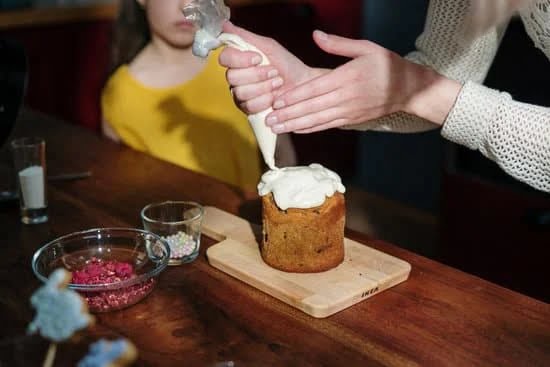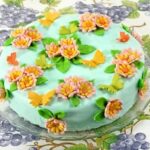Are you wondering how to decorate a wedding cake that will leave a lasting impression on your guests? The wedding cake is more than just a sweet treat – it serves as a centerpiece and focal point at the reception.
Its presence alone can set the tone for the entire event, making it essential to get the decoration just right. From choosing the design and theme to selecting the right ingredients, frosting techniques, adding decorative elements, personalization, cake transportation and troubleshooting issues, there are many aspects to consider when decorating a wedding cake.
The design of the wedding cake holds immense significance as it not only complements but enhances the overall aesthetic of the event. The style and theme of the cake should resonate with the couple’s vision for their special day.
Each element in its decoration plays an integral part in delivering a cohesive look that brings everything together. Therefore, this article will explore all there is to know about creating a beautifully decorated wedding cake that will be memorable for years to come.
When it comes to decorating a wedding cake, attention to detail is key. Whether it’s using high-quality ingredients or mastering specific icing techniques, every step contributes to crafting an impeccable masterpiece that reflects the couple’s style and personality.
Join us as we dive into various aspects of decorating a wedding cake, from selecting designs and themes to tips for successful transportation and assembly at the venue. Let’s ensure that every aspect is as flawless as can be on this momentous occasion.
Choosing the Design and Theme
When it comes to choosing the design and theme for a wedding cake, there are endless possibilities to consider. The design of the cake plays a crucial role in complementing the overall aesthetic of the wedding event. Couples should take into account their wedding theme, venue, and personal style when selecting a design for their cake. Here are some popular design options to consider:
- Classic Elegance: A timeless and sophisticated look featuring clean lines, intricate piping, and elegant floral details.
- Rustic Charm: Perfect for outdoor or barn weddings, this style often incorporates natural elements such as woodgrain textures, fresh flowers, and earthy color palettes.
- Modern Minimalism: Clean lines, bold geometric shapes, and simple yet striking decorations define this contemporary cake style.
To ensure that the chosen design complements the overall wedding theme and style, couples should work closely with their baker or cake designer. It’s important to discuss color schemes, decor motifs, and any specific thematic elements that can be incorporated into the cake design.
The key is to create a cohesive visual experience that ties together all aspects of the wedding decor. By carefully considering the wedding theme and style when choosing the design of their cake, couples can ensure that it becomes a stunning focal point of their celebration.
When exploring different design options for their wedding cake, couples should also keep in mind any cultural or traditional elements that they may want to incorporate. Whether it’s a particular floral pattern, symbolic colors, or specific decorative details, adding these personal touches can make the cake even more meaningful and memorable.
With thoughtful consideration of both aesthetic preferences and thematic relevance, couples can choose a wedding cake design that truly reflects their unique love story and sets an enchanting tone for their special day. This careful selection process will result in a stunning centerpiece that not only looks beautiful but also captures the essence of the couple’s love and celebration.
Selecting the Right Ingredients
When it comes to creating a stunning wedding cake, the importance of using high-quality ingredients cannot be overstated. The flavor and texture of the cake will greatly depend on the quality of the ingredients used. From the flour to the butter, every component plays a crucial role in ensuring that the cake not only looks beautiful but tastes delicious as well.
Flavor combinations and fillings also play a significant role in enhancing the overall taste experience of the wedding cake. When selecting ingredients for your cake, consider unique flavor pairings that complement each other and appeal to a wide range of palates. Some popular flavor combinations include classic vanilla with raspberry filling, decadent chocolate with salted caramel filling, and tangy lemon with blueberry filling.
In addition to flavor, dietary restrictions and allergies should also be taken into consideration when selecting ingredients for the wedding cake. Offering options such as gluten-free or vegan cakes can ensure that all guests can enjoy a slice of cake without any concerns.
Ultimately, selecting the right ingredients for your wedding cake is about creating a memorable sensory experience for everyone in attendance. By choosing high-quality ingredients and thoughtfully crafting flavor combinations, you can ensure that your wedding cake is not only visually stunning but also incredibly delicious. With careful consideration and attention to detail, you can create a masterpiece that will leave a lasting impression on your guests.
Importance of High-Quality Ingredients
Using high-quality ingredients is essential in creating a delectable wedding cake that leaves a lasting impression on guests. Quality flour, butter, sugar, and eggs can make all the difference in both flavor and texture.
Exploring Flavor Combinations and Fillings
When choosing ingredients for your wedding cake, it’s important to explore different flavor combinations and fillings that not only cater to your personal preferences but also cater to those of your guests. Consider incorporating unique and unexpected flavors for an elevated culinary experience.
Accommodating Dietary Restrictions
In today’s diverse society, it’s important to consider dietary restrictions such as gluten intolerances or vegan preferences when selecting ingredients for your wedding cake. Offering inclusive options ensures that all guests can indulge in this sweet treat without worry or hesitation.
Frosting and Icing Techniques
When it comes to decorating a wedding cake, the choice of frosting and icing can make a significant impact on the overall appearance and taste of the confection. There are various techniques for applying frosting and icing, each with its own aesthetic and practical considerations. The right technique can elevate a simple cake into a work of art that complements the overall wedding theme and style.
Buttercream is one of the most popular choices for frosting wedding cakes due to its creamy texture and versatility. It can be smoothed onto the cake for a sleek, elegant look or used to create intricate textured designs. Fondant, on the other hand, provides a smooth, flawless finish that is perfect for creating crisp edges and elaborate decorations. Royal icing is often utilized for delicate piped details such as lace patterns or intricate designs that require precision.
For those looking to learn how to decorate a wedding cake with these different techniques, it is important to understand the proper application methods. Step-by-step instructions for each technique can be found in baking and decorating guides, allowing aspiring bakers to master the art of frosting and icing application. With practice and patience, anyone can achieve professional-looking results.
Experimenting with different frosting and icing techniques can also help in personalizing the cake to reflect the couple’s unique style. Whether it’s incorporating their favorite colors into the design or adding meaningful symbols or motifs, the choice of frosting and icing techniques plays a crucial role in bringing their vision to life. By carefully selecting the right technique for their desired aesthetic, couples can create a truly memorable centerpiece for their special day.
Additionally, when selecting frosting or icing technique it’s important not only consider aesthetics but also pair these choices with flavors that harmonize well with them For example butter cream goes well with lighter spongy cakes whereas fondant could go better with firmer cakes.
Adding Decorative Elements
When it comes to decorating a wedding cake, adding decorative elements is a crucial step in creating a visually stunning masterpiece. Whether you opt for fresh flowers, edible pearls, or other decorative items, these elements can elevate the overall look of the cake and tie into the wedding theme seamlessly. Here are some ideas for adding decorative elements to your wedding cake:
1. Fresh Flowers: Fresh flowers are a classic choice for adorning wedding cakes. From delicate roses to vibrant peonies, incorporating real blooms can bring a touch of natural beauty to the cake. When using fresh flowers, it’s essential to ensure that they are safe for consumption and free from any pesticides or chemicals.
2. Edible Pearls and Jewels: For a touch of elegance and glamour, consider adding edible pearls or jewels to your cake design. These shimmering adornments can create a sense of luxury and sophistication, perfect for formal or black-tie weddings.
3. Unique Decorative Accents: In addition to traditional embellishments, consider incorporating unique decorative accents such as edible metallic leafs, intricate sugar sculptures, or personalized fondant figurines that reflect the couple’s interests and passions.
When adding these decorative elements to the cake, it’s essential to do so carefully to ensure that they are securely attached and will not pose any safety hazards for guests when cutting the cake. Additionally, consider consulting with your baker or decorator for advice on how best to incorporate these decorative touches into your design while maintaining food safety standards.
With these ideas in mind, you can start brainstorming ways to elevate your wedding cake with stunning decorative elements that will leave a lasting impression on your guests.
Personalization and Customization
When it comes to decorating a wedding cake, personalization and customization are key to creating a unique and meaningful centerpiece for the special day. One of the most important aspects of personalizing a wedding cake is to reflect the couple’s personalities and interests in the design.
This can be achieved through various elements such as color schemes, patterns, and even specific motifs that hold significance to the couple. For example, if the couple shares a love for travel, incorporating elements like vintage suitcases or maps into the cake design can be a meaningful touch.
In addition to design elements, personalization can also come in the form of custom cake toppers or monograms. Custom cake toppers featuring figurines of the bride and groom or their pets can add a whimsical and personalized touch to the cake. Monograms are another popular choice for personalizing wedding cakes, whether it’s incorporating the couple’s initials into the design or showcasing their new shared last name.
Furthermore, couples may also choose to incorporate cultural traditions or family heirlooms into the wedding cake design as a way to honor their heritage and create a more meaningful experience for themselves and their guests. For example, using lace from a grandmother’s veil or incorporating traditional symbols or colors from their cultural background can make the wedding cake not only beautiful but also deeply significant.
Ultimately, personalization and customization offer endless opportunities for couples to create a wedding cake that truly reflects who they are as individuals and as partners. By infusing their unique story and style into the design, they can create a stunning centerpiece that will be remembered by all who attend their special day.
| Decorative Elements | Personalization |
|---|---|
| Fresh flowers | Customized Cake Toppers |
| Edible pearls | Monograms |
| Other decorative elements | Cultural traditions/Family heirlooms |
Cake Transportation and Assembly
Transporting a wedding cake to the venue and assembling it can be a daunting task, but with careful planning and attention to detail, it can be done successfully. The first step in transporting a wedding cake is to ensure that you have a sturdy and reliable vehicle, such as an SUV or van, with enough space to accommodate the cake boxes.
It’s essential to drive carefully, avoiding sudden stops or sharp turns that could cause the cake to shift or become damaged.
Once the cake has safely arrived at the venue, the assembly process begins. This is where having a clear plan and proper tools are crucial. Start by setting up a clean, level surface for assembling the tiers of the cake.
It’s helpful to have an assistant or two to lend an extra pair of hands during this process. Begin by unwrapping each tier from its box and carefully stacking them in the desired order, using dowels or support rods between layers to ensure stability.
After stacking the tiers, apply any finishing touches such as decorative elements or piping on the sides of each tier if desired. Finally, step back and admire your masterpiece before presenting it to the newlyweds on their special day.
| Transporting Tips | Assembly Process |
|---|---|
| Use a sturdy vehicle | Set up a clean, level surface for assembly |
| Drive carefully | Unwrap tiers and stack in desired order |
| Avoid sudden stops or sharp turns | Use dowels or support rods between layers for stability |
Troubleshooting and Tips for Success
Common Issues and Solutions
When decorating a wedding cake, it’s common for some issues to arise. One of the most common problems is air bubbles in the fondant or buttercream frosting. To fix this issue, use a pin to gently prick the bubble and then smooth it out with your fingers. Another issue that may occur is the icing cracking or drying out too quickly. To prevent this, keep your work area humid by using a humidifier or damp cloth nearby.
Consistency Is Key
One of the most important aspects of cake decorating is achieving the right consistency with your icing and frosting. If your buttercream is too stiff, add a small amount of milk or cream to soften it up. On the other hand, if it’s too thin, you can add more powdered sugar. When working with fondant, make sure it’s rolled out to an even thickness to avoid any lumps or bumps on the cake.
Time Management
Decorating a wedding cake can be time-consuming, so proper time management is crucial. Create a timeline for yourself and allocate specific tasks for each day leading up to the event. This will help ensure that you have enough time to complete all the necessary decorations without feeling rushed or overwhelmed on the day of the wedding.
By following these troubleshooting tips and advice for success, you’ll be well-equipped to handle any challenges that may arise during your cake decorating process and create a stunning masterpiece that will be the highlight of any wedding celebration.
Conclusion
In conclusion, decorating a wedding cake is an essential part of creating a memorable and visually stunning event. The design and theme of the cake play a significant role in enhancing the overall aesthetic of the wedding, making it an important element to consider.
From selecting the right ingredients to mastering frosting and icing techniques, there are numerous factors to take into account when creating the perfect wedding cake. Fortunately, with the guidance provided in this article, anyone can learn how to decorate a wedding cake with elegance and skill.
By exploring different design options, matching the cake with the overall wedding theme, and using high-quality ingredients, couples can ensure that their cake is not only visually appealing but also delicious. Furthermore, incorporating personal touches and decorative elements can add a unique flair that reflects the couple’s personalities and interests. With careful planning and attention to detail, it’s possible to create a truly unforgettable wedding cake that will be cherished for years to come.
Ultimately, the process of decorating a wedding cake should be approached with creativity, patience, and enthusiasm. By following the step-by-step instructions provided in this article and addressing potential issues that may arise during the decorating process, aspiring bakers can feel confident in their ability to create a stunning masterpiece.
With newfound knowledge and inspiration at their disposal, readers are encouraged to put their skills to the test and embark on their own journey of creating beautiful and personalized wedding cakes.
Frequently Asked Questions
How to Decorate a Wedding Cake?
Decorating a wedding cake requires careful planning and attention to detail. Start by choosing a design that complements the wedding theme and colors.
Use high-quality ingredients for the frosting and decorations, and consider incorporating fresh flowers, edible pearls, or intricate piping to add visual interest. It’s important to practice your decorating techniques beforehand to ensure a beautiful and flawless result on the big day.
How Far in Advance Should You Decorate a Wedding Cake?
When it comes to decorating a wedding cake, timing is crucial. Ideally, you should decorate the cake the day before or on the day of the wedding for optimal freshness and appearance.
However, certain decorations like royal icing or gum paste flowers can be made several days in advance to save time. Just be sure to store them properly in an airtight container at room temperature.
What Are the 3 Tips for Preparing to Decorate a Cake?
Before embarking on decorating a cake, it’s important to make adequate preparations. First, gather all necessary supplies such as icing bags, piping tips, spatulas, and cake boards.
Next, ensure that the cake layers are level, chilled, and ready for decorating by trimming any uneven edges or crumbs. Lastly, familiarize yourself with different decorating techniques by watching tutorials or practicing on parchment paper to hone your skills before working on the actual cake.

Welcome to our cake decorating blog! My name is Destiny Flores, and I am the proud owner of a cake decorating business named Cake Karma. Our mission is to provide delicious, beautiful cakes for all occasions. We specialize in creating custom cakes that are tailored specifically to each customer’s individual needs and tastes.





